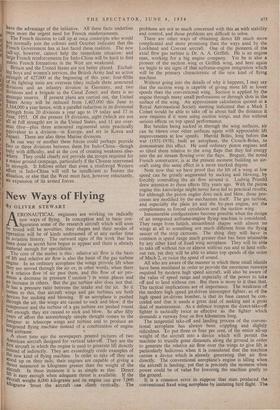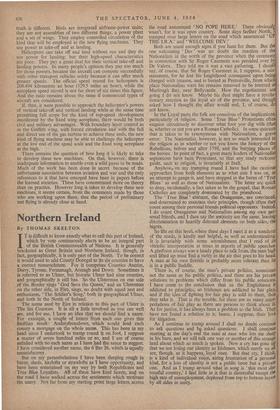New Ways of Flying RY OLIVER STEWART ERONAUTICAL engineers are
working on radically new ways of flying. In conception and in basic con- figuration some of the research aircraft which will soon be tested will be novelties; their shapes and their modes of operation will be of kinds undreamed of at any earlier time in aviation history. The outward signs of the work that has been done in secret have begun to appear and there is already Material enough for speculation. The core of the matter is this : relative air flow is the basis of lift and relative air flow is also the basis of the gas turbine engine. In an ordinary aeroplane the wings provide lift when they are moved through the air or, in other words, when there is a relative flow of air past them, and this flow of air pro- duces a decrease in pressure (` suction ') in some places and an increase in others. But the gas turbine also does just that. It has a pressure ratio between the intake and the jet. So it comes to this, that aircraft wings and gas turbines are both devices for sucking and blowing. If an aeroplane is pushed through the air, the wings are caused to suck and blow; if the fainpressor and the turbine of a gas turbine are pushed round last enough, they are caused to suck and blow. So after fifty Years of effort the astonishingly simple thought comes to the designer to telescope wings and turbine and to produce an integrated flying machine instead of a combination of engine and airframe.
A short time ago the newspapers printed pictures of two American aircraft designed for vertical take-off. They are the first aircraft in which the engine is used to generate lift directly !instead of indirectly. They are exceedingly crude examples of the new kind of flying machine. In order to take off they are stood up on their tails; their engines are capable of giving a mrust measured in kilograms greater than the weight of the aircraft. In these instances it is as simple as that. Direct t is easy enough when adequate thrust is available. If the weighs 6,000 kilograms and its engine can give 7,000 . Kilograms thrust the aircraft can climb vertically. The problems are not so much concerned with this as with stability and control, and those problems are difficult to solve. There are other ways of obtaining direct lift much more complicated and more promising than the ways used by the Lockheed and Convair aircraft. One of the pioneers of the axial flow gas turbine is Dr. A. A. Griffith. He is an engine man, working for a big engine company. Yet he is also a pioneer of the suction wing or Griffith wing, and here again we begin to see signs of that airframe-engine integration which will be the primary characteristic of the new kind of flying machine.
Without going into the details of why it happens, I may say that the suction wing is capable of giving more lift at lower speeds than the conventional wing. Suction is applied by the engine through many small perforations or through slots in the surface of the wing. An approximate calculation quoted at a Royal Aeronautical Society meeting indicated that a Mark I Comet would be able to take off in about half the distance it now requires if it were using suction wings, and this without serious effects on top speed performance.
But besides being sucked in through the wing surfaces, air can be blown over other surfaces again with appreciable lift improvements at low speeds. Harold Bolas, long before the war (1931-1938), built an aeroplane, the Crouch-Bolas, to demonstrate this effect. He used ordinary piston engines and so tilted them relative to the wing flaps that they fed energy into the air stream flowing over the flaps. Breguet, the noted French constructor, is at the present moment building an air- craft using this same effect in a more marked degree.
Note now that we have proof that the lift of a wing at low speed can be greatly augmented by sucking and blowing, by forcibly controlling the air flow around- it. Ludwig Prandtl drew attention to these effects fifty years ago. With the piston engine this knowledge might never have led to practical results; for although the piston engine does suck and blow, those pro- cesses are modified by the mechanism itself. The gas turbine, and especially the plain jet and the by-pass engine, are the complements to forced circulation and the suction wing.
Innumerable configurations become possible when the design of an integrated airframe-engine flying machine is considered. They range from fattish, streamlined shapes with almost no wings at all to something not much different from the flying saucer of the strip cartoons. The thing they will have in common is speed range much greater than has been attainable by any other kind of fixed wing aeroplane. They will be able to take off without fun or almost without run and to land with- out run, yet they will be able to attain top speeds of the order of Mach 2, or twice the speed of sound.
All who are aware of the manner in which these small islands have been mutilated in order to provide the enormous runways required by modern high speed aircraft, will also be aware of the value of speed range and especially of 'the power to take off and to land without run. But there is more to it than that. The tactical implications are of importance. The weakness of the modern high speed jet-driven interceptor fighter, as of the high speed jet-driven bomber, is that its base cannot be con- cealed and that it needs a great deal of making and a great deal of maintenance. As a defence weapon the direct-take-off fighter is tactically twice as effective as the fighter which demands a runway four or five kilometres long.
The tangential take-off and landing process of the conven- tional aeroplane has always been crippling and slightly ridiculous. To put three or four per cent. of the entire all-up weight of the aircraft into a device which will permit the machine to trundle great distances along the ground in order to generate the relative air flow over the wings to give lift is particularly ludicrous when it is considered that the machine carries a device which -is already generating that air flow directly. The conventional aeroplane's engine is idling when the aircraft is landing; yet that is precisely the moment when power could be of value for lowering the machine gently to the ground. It is a common error to suppose that man produced the conventional fixed wing aeroplane by imitating bird flight. The truth is different. Birds are integrated airframe-power units; they are not assemblies of two different things, a power plant and a set of wings. They employ controlled circulation of the kind that will be employed in the new flying machines. They use power at take-off and at landing. Helicopters can take off and land without run and they do use power for landing; but their high-speed characteristics are poor. They pay a great deal for their vertical take-off and landing powers. In many people's opinion they pay. too much for those powers, because the aircraft can compete successfully with other transport vehicles solely because it can offer much greater speeds. The official speed record for helicopters is 208.494 kilometres an hour (129.5 miles an hour), while the aeroplane speed record is not far short of six times this figure. And the ratio remains about the same if commercial types of aircraft are considered.
If, then, it were possible to approach the helicopter's powers of vertical take-off and vertical landing while at the same time permitting full scope for the kind of top-speed development manifested by the fixed wing aeroplane; there would be both civil and military advantages. With boundary layer control as in the Griffith v.ing, with forced circulation and with the full and direct use of the gas turbine to achieve these ends, the new kind of flying machine may be able to challenge the helicopter at the low end of the speed scale and the fixed wing aeroplane at the high.
There remains the question of how long it is likely to take to develop these new machines. On that, however, there is inadequate information to enable even a wild guess to be made. Much of the work has been done in secret because of the unfortunate association between aviation and war and the only references to it that have emerged have been in papers before the learned societies. 'These have concentrated More on theory than on practice. However long it takes to develop these new machines, it seems certain, from the comments made by those who are working upon them, that the period of preliminary test flying is already close at hand,



































 Previous page
Previous page